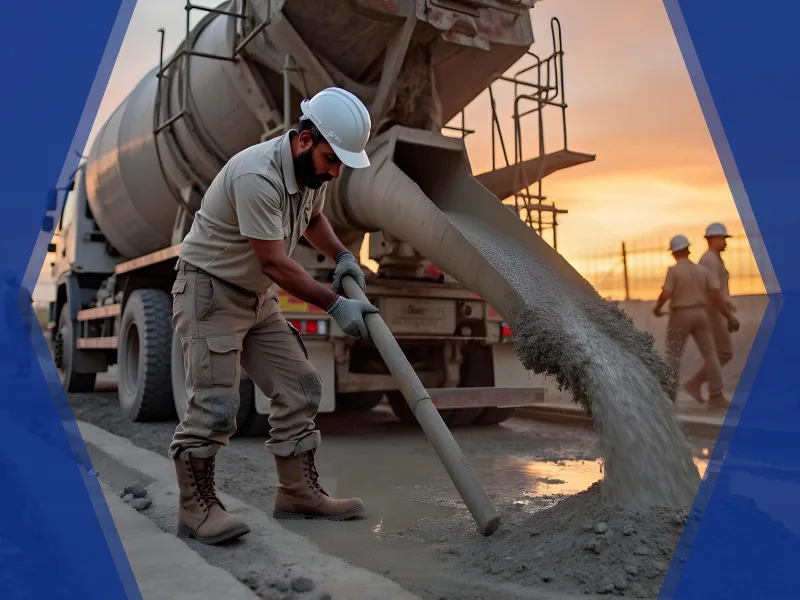For something that’s known as the “world’s most widely used man-made material,” concrete’s production methods have remained traditional for a long time. Mixing concrete on-site was the norm for decades. The introduction of Ready-Mix Concrete (RMC) in mid-20th century changed that by centralizing the mixing process in dedicated plants, delivering consistent and ready-to-use concrete to construction sites. Today in India, the construction demands are growing rapidly and hence RMC is playing a key role in improving quality, speeding up projects as well as managing resources more efficiently.
What is Ready-Mix Concrete and How Is It Different?
Ready-Mix Concrete (RMC) is made at a central plant. All ingredients such as cement, aggregates, water, and additives- are measured and mixed precisely. The fresh ready-to-use concrete is then delivered to the construction site in special mixer trucks. This is different from traditional site-mixed concrete where raw materials are brought to the site and mixed manually or with small mixers, which is usually inconsistent and slow.
RMC offers some clear advantages:
- Consistent quality: RMC is produced in controlled environments with automated batching systems. This ensures uniform strength, workability, and setting time. It eventually reduces quality-related issues on the site.
- Faster construction: With concrete arriving ready to pour, project timelines are shortened. There’s no waiting for manual batching or delays due to inconsistent mixes.
- Less dependency on labor: On-site mixing requires skilled workers to maintain the quality. RMC reduces the need for such manpower, which is helpful especially in cities that are facing labor shortages.
- Less material waste: Centralized batching means that exact quantities are mixed- cutting down on cement, sand, and water wastage. This also supports more sustainable construction practices.
- Safer and cleaner sites: Since no or very less raw materials need to be handled or stored on-site, there’s less dust, clutter, and risk of accidents. This helps to maintain a more organized & efficient worksite.
Where RMC is commonly used?
RMC is no longer limited to premium projects. It’s becoming the default choice across sectors because of its reliability and speed. Here’s where it’s making the biggest impact:
1. High-Rise Buildings and Urban Housing Projects
Speed, quality, and limited site space make RMC ideal for residential and commercial towers in urban India.
2. Infrastructure Projects (Roads, Bridges, Metros)
Infrastructure demands precision and scale—both of which RMC supports with large-volume, consistent deliveries.
3. Industrial Facilities and Warehouses
Factories and logistics parks often require durable, load-bearing floors and fast-paced construction schedules. RMC helps meet those needs efficiently.
4. Institutional and Public Sector Projects
Hospitals, schools, government buildings, and transport hubs benefit from the speed and standardization RMC offers.
5. Private Villas and Small Residential Projects
Even smaller builders are shifting to RMC to avoid the hassle and mess of on-site mixing- especially in semi-urban areas with limited labor availability.
Challenges and Considerations
One of the key challenges is logistics- RMC must be delivered and poured within a set timeframe (typically 90 minutes) after mixing. Any delays in traffic or on-site unloading can affect the quality. Also, not all construction sites are easily accessible for transit mixers, especially in congested urban areas with narrow roads or space constraints.
Another factor is dependency on the supplier’s reliability. Delays or miscommunication from the batching plant can disrupt site schedules. RMC also tends to be less suitable for very small projects, where minimum order quantities make it less economical. Unlike site-mixed concrete, last-minute changes aren’t always possible, so RMC use demands advance coordination on mix specifications, delivery timings, and site readiness.
Conclusion
Ready-Mix Concrete is no longer just a convenience, it’s becoming a necessity in modern construction. By offering consistency, speed, and cleaner worksites, it solves many of the inefficiencies tied to traditional mixing methods. While it does require better planning and coordination, the long-term gains are hard to ignore. In the next blog in this series, we’ll explore how exactly it’s transforming the construction scene across the country.
